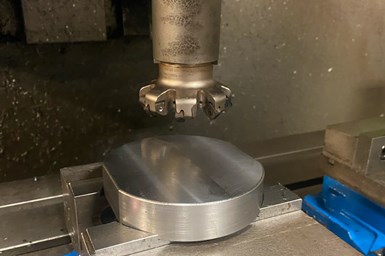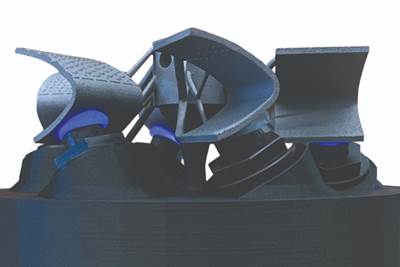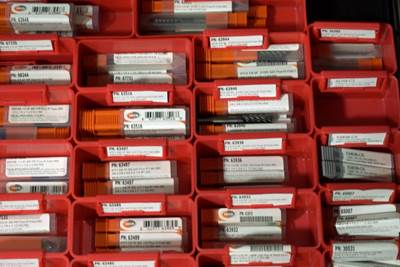All-Around Mill Improves Productivity and Cost for Valve Job
Adopting a mill with a double-negative rake and pockets compatible with multiple insert geometries enabled Progressive Metal Service to increase feed and lower scrap rates for a valve.

Progressive Metal offers gate valves in five sizes, with additional variants to account for different PSI needs. Cycle times plummeted from 40 minutes to nearly half that with the introduction of Tungaloy’s DoTriple-Mill and cutting inserts. Photos courtesy of Progressive Metal Service.
New capabilities bring new opportunities, but sometimes the greatest opportunities come from improving existing processes. For Progressive Metal Service, a coating; assembly; salt bath nitriding; and turnkey manufacturing company, new tooling for a routine face milling application led to significant cycle time and tooling cost reductions. This opportunity came about after machining general manager Mike Johnson joined the company in December 2021 and began identifying applications with room for improvement.
Johnson’s initial improvement strategy focused on one of Progressive Metal’s staple jobs: machining the internal components of gate valves. The company’s customers primarily use these valves to control the flow of liquids and mud at fracking sites. Progressive Metal makes five different sizes of this part with holes ranging from two to seven inches in diameter, as well as variants for different levels of PSI. Depending on the build requirements, these valves can be 4130 heat-treated steel or Inconel 718.
Seeking a Can-Do Solution
Johnson contacted Tungaloy sales engineer Greg Davis, whom Johnson knew from his previous position, and obtained a recommendation for the DoTriple-Mill.
According to Johnson, the DoTriple-Mill alone cut cycle time by between 30% and 40% — with further optimizations saving another 10%.
The cutter’s ability to use round, square and octagonal inserts (the “Triple” of the mill’s name) in the same pocket was a key selling point, although Progressive uses only round and square inserts. As Davis puts it, “[the DoTriple-Mill] may not necessarily be the ideal cutter for any one application, but it is a good all-around cutter that will handle different materials just by changing the insert geometry.” For example, square inserts maximize metal removal for 4130 applications, while round inserts resist wear and support longer tool life in Inconel applications.

Tungaloy’s DoTriple-Mill includes slots for cutting inserts with round, square and octagonal geometries. Progressive Metal uses square inserts on its 4130 heat-treated steel pieces and round inserts on its Inconel 718 pieces.
All-Around Improvements
Progressive Metal Service previously used a 5-inch-diameter, 45-degree-lead face mill on its gate valves, but between high cutting forces and a process that only gripped 0.1 inch of material, this setup could lift the part out of the vise and damage part, insert and cutter. The close-pitch version of the DoTriple-Mill and the new inserts have a starker, double-negative rake angle that leverages cutting forces to push the part into the vise, better securing it and enabling Progressive Metal’s machinists to increase both feed rates (unusual for a double-negative rake) and depths of cut.
With Tungaloy’s cutter and square inserts, Progressive Metal machines its 4130 gates at 500 sfm and 0.075-inch depth of cut, and between 0.012 and 0.018 inch per tooth depending on how much material Johnson can clamp. The DoTriple-Mill reduced the process’ original 40-minute cycle time by between 30% and 40%, Johnson says, with further optimizations saving another 10%. These productivity improvements and the elimination of job-specific tooling by switching to the DoTriple-Mill ultimately halved the company’s tooling costs for the job.

Progressive Metal’s valve gates progress through five process stages: raw material; facing and profiling; t-slotting and chamfering; grinding; and nitride coating.
The DoTriple-Mill’s negative rake additionally helps hold the valves’ shape, reducing the amount of finish grinding they need. Reprogramming was also simple, with Johnson adjusting Progressive Metal’s machine programs in around 15 minutes.
As for the rest of the machine shop staff, Johnson says adoption went smoothly, with their main question stemming from the cutter’s durability: “When is it going to wear out?”
Related Content
How to Turn Machine Shop Downtime Into Process Expertise
To take advantage of a lull in business, JR Machine devised a week-long cutting tool event that elevated the shop’s capabilities with aerospace alloys.
Read MoreHow to Mitigate Chatter to Boost Machining Rates
There are usually better solutions to chatter than just reducing the feed rate. Through vibration analysis, the chatter problem can be solved, enabling much higher metal removal rates, better quality and longer tool life.
Read MoreHow to Tackle Tough Angled Pocket Milling With Two Tools
Milling a deep pocket with a tight corner radius comes with unique challenges, but using both a flat bottom drill and a necked-down finishing tool can help.
Read MoreToolpath Improves Chip Management for Swiss-Type Lathes
This simple change to a Swiss-type turning machine’s toolpath can dramatically improve its ability to manage chips.
Read MoreRead Next
Back to the Charts for Productive Milling
Roughing operations can push a CNC spindle to its limits. Understanding how to interpret the horsepower chart can keep these operations within safe limits.
Read MoreChoosing Workholding to Meet Machining Challenges
When it comes to workholding, shops can choose from options that can provide flexibility, help increase throughput and enable five-axis machining.
Read MoreCutting Tool Inventory: A Big Concern for Small Shops
A job shop might have an amount of money tied up in tooling equal to a significant share of its investment in CNC machines. Here is how one shop owner thinks about tool management.
Read More







.png;maxWidth=300;quality=90)


















